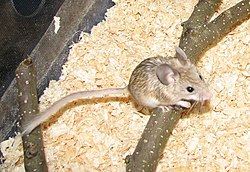Calomyscus
| Mouse-like hamsters Temporal range: Late Miocene–Recent |
|
|---|---|
 |
|
| Calomyscus | |
| Scientific classification | |
| Kingdom: | Animalia |
| Phylum: | Chordata |
| Class: | Mammalia |
| Order: | Rodentia |
| Superfamily: | Muroidea |
| Family: |
Calomyscidae Vorontsov & Potapova, 1979 |
| Genus: |
Calomyscus Thomas, 1905 |
| Species | |
|
Calomyscus bailwardi |
|
Calomyscus bailwardi
Calomyscus baluchi
Calomyscus elburzensis
Calomyscus grandis
Calomyscus hotsoni
Calomyscus mystax
Calomyscus tsolovi
Calomyscus urartensis
Mouse-like hamsters are a group of small rodents found in Syria, Azerbaijan, Iran, Turkmenistan, Afghanistan, and Pakistan. They are found in rocky outcrops and semi-mountainous areas in desert regions.
The mouse-like hamsters are not true hamsters, but represent an early split from the rest of the mouse-like rodents. They were once thought to be hamsters based on the shape of their molars, but they lack the cheek pouches, flank glands and short tails of the true hamsters. The closest relatives of the mouse-like hamsters may be the extinct Cricetodontidae. Because of their seemingly early break from the rest of the mouse-like rodents, mouse-like hamsters have been placed in a family of their own, Calomyscidae, and have been referred to as living fossils.
All members of the genus were once considered part of the same species, Calomyscus bailwardi, but the two are now referred to as separate species due to major differences in chromosome number, skull measurements, and other features.
...
Wikipedia
